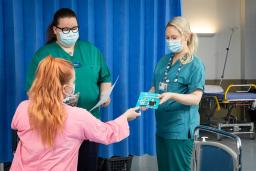Biobank samples as part of cancer prevention
Keywords:Cancer is often only diagnosed in the metastasized stage, when it requires heavy treatments and its prognosis has become worse. The best treatment is to detect cancer as early on as possible or identify people at high risk to plan preventive measures.

The susceptibility mutation of high-risk breast cancer is carried by every 200 Finnish women or men. A care pathway has been developed at HUS to guide carriers of genetic risks observed in biobank samples for enhanced screening and, if necessary, targeted treatment of breast cancer.
One in two hundred Finns carries one of the high-risk mutations BRCA1, BRCA2 and PALB2 breast cancer genes. People are often unaware of their risk. These mutations that predispose to breast cancer cause the disease in women at a younger age than average and even before the age when regular screening starts. Carriers of the BRCA1 or BRCA2 mutation have a 70% risk of developing breast cancer by the age of 80. Cancer mutations of the BRCA1, BRCA2 and PALB2 genes are hereditary.
The identification of the susceptibility to breast cancer is based on biobank samples
The identification and care pathway developed at HUS for carriers of the high-risk gene for susceptibility to breast cancer is based on biobank samples.
A biobank sample will be collected and stored in the biobank from the volunteers who provide their consent for a biobank sample. The most common type of sample is a blood sample, but other sample types, such as urine and tissue samples, are also collected. These samples will be used for various medical research studies, some of which are related to the causality of genetics and diseases. The genome data analyzed from the sample will be returned to the biobank.
If a mutation that poses a significant risk of cancer is detected from the returned data, the matter will be transferred from the biobank to the healthcare provider and the HUS physician or nurse will contact the provider of the biobank sample. If they wish, these individuals will receive enhanced screening and, if necessary, preventive measures will be performed, such as breast removal, i.e., mastectomy. The next of kin can also be tested at their discretion.
Biobank samples and data analyzed from them
- The carriers of the three susceptibility mutations for breast cancer can be identified already before the cancer has developed.
- More information about cancer is available.
- The drug therapy and its dosage will be specified.
A care pathway developed at HUS when a gene predisposing to breast cancer is found
- Biobank samples provide information identifying genes that significantly predispose to breast cancer.
- The person carrying the susceptibility mutation is contacted, if they have given their permission.
- Individual enhanced prevention of breast cancer.
More than a 100 high-risk individuals carrying the breast cancer gene mutation were identified in the pilot project
Currently at the Helsinki Biobank genome data generated in biobank studies have been returned for 80,000 patients. In the pilot project now implemented and funded by the Ministry of Social Affairs and Health, more than a 100 people have been identified from among the biobank sample donors so far who carry a high-risk breast cancer gene mutation.
The ongoing research project involves three genes: BRCA1, BRCA2, PALB2 with risk variants significantly increasing the risk of breast, ovarian and prostate cancer. The goal is to determine the suitability of genomic data returned from the biobank studies for screening and the usefulness of the data in clinical practice.
There are clear guidelines in place at healthcare services, if a risk variant is found in a biobank sample
As a result of the project, there are already clear guidelines on how to act in healthcare if any of these risk variants are found in a patient’s or their relative’s sample as a result of a biobank study.
As part of the study, the sample donors will also be asked whether they want to receive information relevant to their health. The study will also produce practical experiences on the returning of information and on providing guidance. Based on the current results, the receipt of the study has been solely positive. In addition, a cost-effectiveness analysis is ongoing.
Participants in the study include HUS Comprehensive Cancer Center, HUS Diagnostic Center, and Helsinki Biobank.